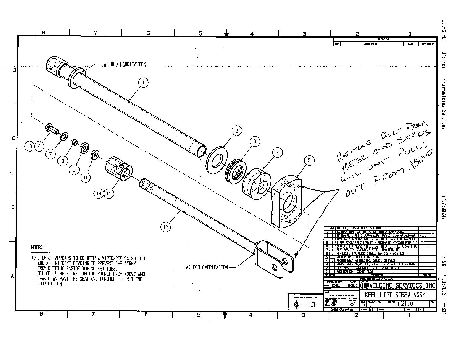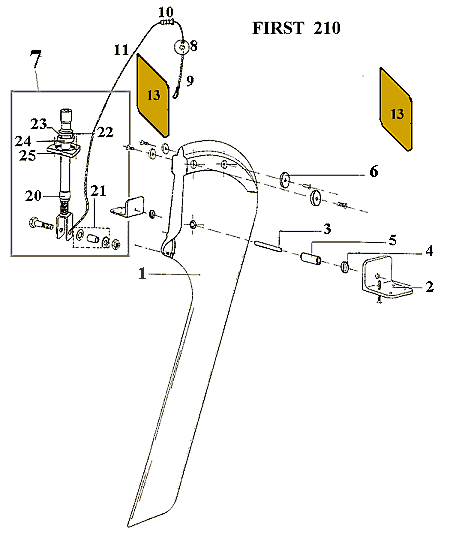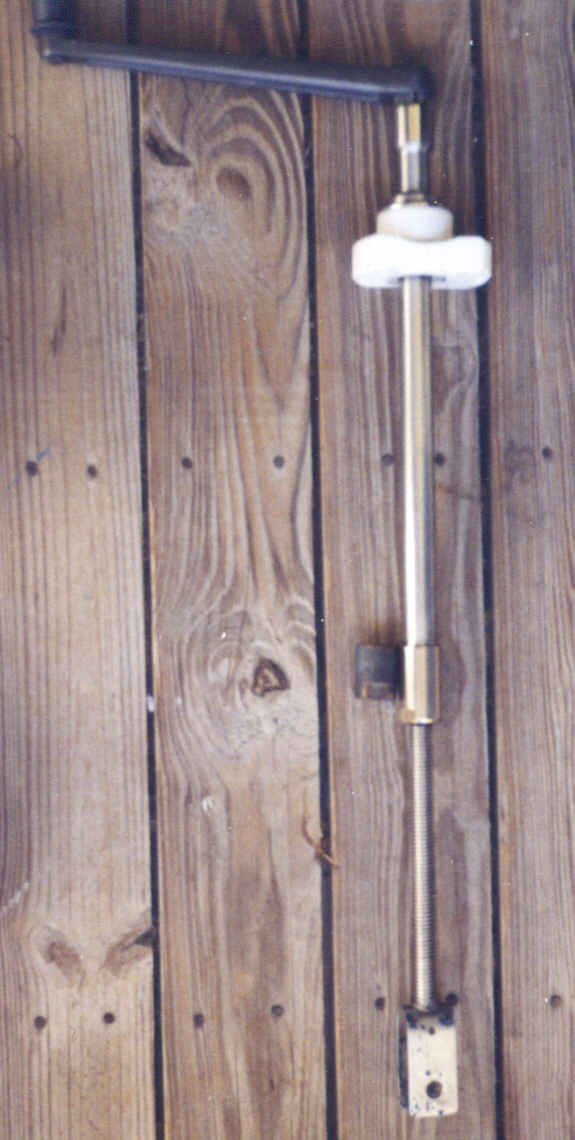Beneteau First 210 Tech Notes
Title: Replacing Swing Keel Lifting Mechanism
Author: Terry F. Ellis
This describes what Bob Field (owns 1993 First 21.0 Swing Keel model
Hull #63) did to repair the broken keel lifting screw mechanism on his
F210 (plus comments from a Rod Forman and Jay Harrell regarding the repair
and swing keel lifting apparatus in general):
Terry,
I received your thought provoking note re: keel lift. The one Beneteau
sent me is the "improved " version so I'm sure Ward Richardson could be
aware of the changes. In fact they sent me two and I returned one to Marion
SC. As I explained to Rod Forman, the new one had a longer bronze collar
(more threads?) and what appeared to be a greater pitch (Wider) to the
threads for greater durability. I certainly agree that recognizing a weakness
and high failure rate in the original mechanism, (sufficient to make an
engineering change) they (Beneteau) should at the very least, if not replace
the deficient part, make some cost adjustment, as mine cost $350 plus shipping.
If I can provide any information to them, let me know. Warmest Regards.
Bob Field Hull #63
-----Original Message-----
To: Bob Field & rod forman
Cc: Ward Richardson <ward.richardson@beneteauusa.com>
Date: Friday, November 02, 2001 10:20 AM
Subject: RE: Bob Field's Broken F21.0 Keel Lifting Shaft
I agree with all of your conclusions. Bob Field told me he wanted the
mechanism back so he could make a claim against Beneteau. I think if you
took some pictures of it and mention all of us who witnessed it, that would
be sufficient "evidence" for Beneteau USA. Moreover, I think Beneteau USA
would like for "us" to "reinvent" this keel lifting shaft such that it
would be: a) more durable b) easier to use (i.e. fewer turns up to down)
c)less "clunky" (i.e. have bigger nylon discs to cushion the keel and make
it more "fair" d) cheaper to fix (i.e. just a new "collar" vs. a whole
new worm shaft/rod/collar/shackle e) something that would take up less
space in the cabin (i.e. a "gear" that would come out under the companionway
step or be electronic vs. sticking up right in front of the porta potti
and vee-berth) and f) something that would withstand trailering whether
or not the keel is resting on a trailer support pad (I suspect just the
bouncing of the boat harms the screw mechanism even if/when the keel is
resting properly on it's bunker not to mention I believe a collision of
the keel with a rock under sail can/does damage the lifting worm gear-should
have an "awl" releasing mechanism in the event of a hard blow). I think
you should contact Ward Richardson at Beneteau USA, tell him what we've
discovered and get B to budget money and parts for you to design/produce
a better mechanism. Having said that, I understand that the "new First
211 Spirits" produced/sold only in Europe now, have a better mechanism,
one that was re-designed from the original F21.0 contraption. I understand
it has a better "purchase angle" and a better collar and screw shaft. It
would be good if Ward would order one of those from France and ship it
to you for inspection. I, for one, believe B should offer to replace the
lifting mechanism on every F21.0 sold since the boat was introduced in
1993. There are only about 60 of them around in the USA (40 are fixed keel
"Classic" models like mine). Including labor, the "retrofit" might cost
Beneteau $500 a boat. That's $30,000; not a small sum yet the "right thing
to do" and...what Catalina Yachts would/did do on the mast, mast step,
spreader and forestay chain plate on the Catalina 22s, all of which were
subject to failure in C-22s made from 1970 to 1980...some 9,000 boats!
And here are conclusions made upon inspection of Bob Field's old lifting
screw by Bob Forman, a machinist (who also owns of a Beneteau First Class
8 with similar swing keel/lifting mechanism):
------------
Hi Terry,
I have disected and deseminated the heck out of this thing. The major
faults with it that I can see are:
1: too fine a thread which translates to to thin a thread cross section
ie. structural strength under load especially after wear, I elaborate later.
2: too short an engagement length of thread in the nut which further
reduces structural strength.
3: too small a screw diameter which again reduces available strength
Bob Field told me (my remembrance)that he paid around $350.00 for the replacement.
While he did not examine the new unit with calipers such as I have the
old one he said that there were "visible" differences translating to an
"apparent sense" of a stronger unit. That's tough to quantify. As I said
in earlier posts the design is an improvement in many regards to the earlier
(ala First Class 8) unit that I personally am more familiar with. It is
eveident however that they have had a reasonable amount of previous failures
to warrant an improved unit for more recent models. As designed however
the unit will raise into the cabin, without any damage to the screw mechanism,
when an under water obstacle is contacted with any force. Jay, Niels and
I all noticed this during the the Rendezvous Regatta when we all encountered
that previously unknown "Sea-Tittie" in the course. That personally is
another safety related issue that I have with the uni
t that is unrelated to strength and reliability.
I will assume that you are going to forward what I'm writing here so
I will try and keep it in simple terms. I will comment on the 3 points
of weakness made earlier.
1: too fine a pitch. This is a long subject. Understand that with any
"screw" mechanism you are balancing effort and strength with function.
The choice between a fine or coarse pitch screw is based on several design
criteria.
A screw is basically one of the oldest of mans tools, the inclined
plane, wrapped around a shaft. The pitch translates through diameter to
angle of incline. The greater the pitch, helix angle, the steeper the incline
and the greater the effort to raise the load. A finer pitch has a lower,
easier, angle so less effort. This is however relative to diameter. Using
the standard keel lifting screw for example, it is of 18mm diameter with
3mm pitch, it moves the screw 3mm for every turn. It has a helix angle
of approx. 3 degrees. An 18mm x 4mm screw has 4 degrees of helix, more
angle more effort. A 20mm x 4mm screw has a 3.6 degrees helix angle. Less
angle than an 18mm screw of the same pitch thus less effort more strength
than an 18mm x 4mm. About 20 fewer turns than the 18mm x 3mm. With standard
nuts and bolts there are "fine and coarse" pitches available as standard.
The primary reason for use of a fine pitch is that tha mall diameter of
the screw thread is larger and thus stronger. Also tha helix angle is less
so it does not unwind or come loose as easy. The load holding capability
though is roughly equal because of the surface area of thread engagement
is roughly equal. 5 threads of a wide depth has the equal surface area
as 10 threads of a shallow depth. The kicker comes when you factor in wear
which is not and issue in a "nut and bolt" application but IS in a screw
used for POWER TRANSMISSION. Surface wear affects a fine pitch the same
as a coarse pitch, ths fine pitch just has THINNER threads. As they wear
they get even thinner till the cross section is too weak to support the
load. Then they shear. That is the inevitable failure mode.
2: too short a length of thread engagement. Standard mecahnical practise
for "nut and bolt" applications are a length of engagement to equal 1 thread
diameter. For POWER TRANSMISSION applications that increases to a minimum
length of 1.5 times the thread diameter. The reason is to allow for the
reduction of thread cross section and strength due to wear.
3: too small a screw diameter. While the screw as is, is strong enough
to support the load, a larger one will support it better. It will also
allow you to go to a coarser pitch, which raises the keel with fewer turns,
with out greatly increasing the effort invovled over the smaller diameter
screw. Bronze has about 60% of the mechanical strength of steel or stainless.
It does have some natural lubricity. Also you do not want to use stainless
on stainless because without proper lubrication, it WILL SEIZE and stick.
Bronze is a good choice though if the structural section is adequate. From
my examination of the components a 20mm screw will fit with out any modifications
to other components. A 4mm pitch will have a bit more effort than the 3mm
BUT, WORK = WORK. 60 turns to lift 700 lbs at a more agressive rate equals
the combined effort of 80 turns to lift 700 lbs at an easier rate. You
also must realize that the coefficient of friction of bronze to stainless
steel is such that 35%-40% of the effort that you feel when turning the
crank is just to over come friction. Also as the device uses a winch handle
to actuate it would be wise to buy a 10" handle, for greater leverage,
over the supplied 8" handle.
Now that everyone knows more than they ever wanted to know about power
screw mechanisms, and I'm tired of typing, I'll leave it for now. Damned
dead horse, no matter how many times I kick it, it stays dead.
------------
Rod,
This summer I noticed my keel getting harder and harder to raise each
time I went out. The owners manual didn't mention lubricating the threads,
only the bearing. So I poked around until I realized that I could pour
oil down the hole where the winch handle sits and it would coat the threads.
I used SAE 30 motor oil because it's what I had handy. This worked great
so far and now the keel comes up smoothly once again.
Jay Harrell
------------
Jay,
Would "white grease" such as used on power seat screw gears in automobiles
work better than SAE 30 Engine Oil?
Terry
------------
Terry,
It might, however, it would be impossible to get the white grease down
in the lub hole in the lifting mechanism at the keel trunk. SAE 30 wt oil
is readily available and can be easily put into the shaft oiling hole any
time...once a month or every time we go sailing...whatever's needed.
Jay
------------
(edited and paraphrased by T. Ellis)

Hi res image click here


Title: Replacing Swing Keel Lifting Mechanism
Model(s): First 210
System(s): Keels
Author: Terry F. Ellis
updated May 12, 2004
|